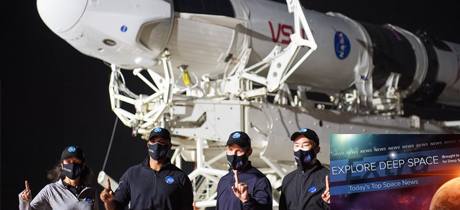Happy Veteran’s Day! The Coalition for Deep Space Exploration thanks all veterans for their service.
In Today’s Deep Space Extra… Senate appropriators hold back on spending for NASA’s Human Landing System (HLS). NASA and ESA are prepared to bring samples from Mars to Earth, an independent report concludes.
Human Space Exploration
NASA and SpaceX tentatively clear Crew Dragon for launch to space station
Coalition Member in the News – Boeing
CBS News (11/11): SpaceX and its planned Crew-1 mission emerged from a two-day NASA flight readiness review on Tuesday cleared to launch from NASA’s Kennedy Space Center (KSC) on Saturday with four astronauts to the International Space Station (ISS), weather and technical issues permitting. A hot fire test of the nine Falcon 9 first stage Merlin engines, however, was reset from Tuesday to Wednesday in order to replace a valve in a second stage rocket engine.
Senate Appropriations Committee sticks a fork in NASA’s 2024 Moon landing plan
Parabolicarc.com (11/10): NASA’s efforts to achieve a return of humans to the surface of the Moon by the current deadline encountered another setback on Tuesday as the U.S. Senate Appropriations Committee released its 2021 spending bill for Fiscal Year 2021. The bill includes $1 billion for NASA’s commercial lunar Human Landing System (HLS), short of the agency’s $3.2 billion request. The House, which acted over the summer, provided $628.2 million for the landing system. Overall, the Administration sought $25.2 billion for NASA in 2021, a $2.6 billion increase. The Senate measure provides $23.5 billion overall, and the House version $22.6 billion.
Space Science
100 Days From Arrival, JPL Readies Perseverance Rover for Mars Landing
Pasadena Now (11/10): Launched on July 30, the NASA Perseverance rover is well over halfway on its journey and less than 100 days from a highly anticipated landing at Mars’ Jezero Crater. Upon reaching Mars in February 2021, the rover will begin its mission to collect and cache samples of rock and soil for an eventual return to Earth, where they will be assessed for evidence of past life on Mars.
NASA-ESA’s Mars sample return mission on track, report says
Spacewatch Global (11/11): NASA is on track to bring samples from Mars to Earth, says a report from the Mars Sample Return (MSR) Independent Review Board (IRB). The review started in August to ensure the return mission is positioned for success. The Mars return mission campaign will require three spacecraft provided by both NASA and ESA.
Photogenic comet approaches Earth
Spaceweather.com (11/10): Comet Atlas is on course to make its closest approach to Earth on Saturday, November 14. The greenish object will likely be difficult to see with the naked eye, but its move through the constellation Orion should make it an achievable target with a backyard telescope or binoculars.
Other News
Blue Origin and Aerojet get in on NASA partnerships for new space technologies
Coalition Members in the News – Aerojet Rocketdyne, Maxar, Northrop Grumman
GeekWire.com (11/9): NASA has selected 17 U.S. companies to mature technologies for the Moon and beyond. The NASA and industry teams will develop fuel to propel deep space small spacecraft, test a new method to remove dust from solar arrays, develop a small spacecraft electric propulsion system, and more. The agreements will provide the companies with access to an estimated $15.5 million in NASA facilities and capabilities.
Biden-Harris transition team names landing party members
Spacepolicyonline.com (11/10): The names of Biden-Harris transition team members for a range of federal agencies were released on Monday, including NASA’s. NASA’s transition team is led by Ellen Stofan, director of the National Air and Space Museum. Stofan is a planetary scientist and former NASA chief scientist during the Obama administration and previously a senior scientist at the Jet Propulsion Laboratory (JPL). The panel includes Pam Melroy, a retired NASA astronaut, and Bhavya Lal, of the IDA Science and Technology Policy Institute, a Washington nonprofit established by Congress to advise the White House Office of Science and Technology Policy (OSTP).
RUAG Space: New powerful computer for satellites
Coalition Member in the News – RUAG Space
SpaceNews.com (11/10): RUAG Space has developed a new computer for satellites called “Lynx”. The computer is 250 times more powerful than the processors RUAG has been provided for satellites in the past, and offers flexibility in terms of communication, interface and processing capability.

